Healthcare Mobile App Development: Features, Best Practices, and Trends
Updated 22 Oct 2025
28 Min
8161 Views
App development for healthcare is reshaping how providers deliver care and interact with patients. Hospitals, clinics, labs, and healthtech startups are under growing pressure to innovate, starting from enabling remote care to automating outdated workflows and improving data accuracy. One of the key tools driving this transformation is mobile technology. By investing in digital solutions, including healthcare mobile app development, these organizations are modernizing their operations and enhancing how care is delivered.
At Cleveroad, we’ve spent over 15 years building compliant, high-performing healthcare software: from EHR-integrated telemedicine platforms to AI-powered diagnostic assistants. Our portfolio contains a bunch of healthcare case studies demonstrating how technology can simplify clinical processes and enhance patient outcomes.
Based on our years of experience in healthcare app development, we’ve created this guide to help you:
- Learn how healthcare app development drives digital transformation in medicine
- Discover essential medical app types and features for improving care quality and compliance
- See real-world examples of how Cleveroad builds healthcare apps that meet compliance standards
What Is a Healthcare Application
A healthcare app is a digital solution that revolutionizes the way medical institutions manage health and wellness. Whether it’s booking a doctor’s appointment, monitoring fitness goals, accessing telemedicine, or managing chronic conditions, these apps put healthcare at yours and your patients' fingertips. Mobile healthcare application development provides users with real-time medical data, and personalized insights and facilitates seamless communication with medical professionals, all while ensuring high-security standards within sensitive medical information.
Beyond convenience, the goal of healthcare applications is to improve diagnostics, enhance communication between doctors and patients, and enable effective remote care. Through healthcare interoperability, such systems connect hospitals, labs, and clinics and other medical institutions into one ecosystem that streamlines data exchange and treatment coordination.
Why healthcare app market grows fast
For most healthcare facilities, mobile health app development has become a real game-changer. Such digital tools allow medical professionals to securely access, analyze, and exchange patient data in real time, which helps deliver faster and more accurate care.
The demand for healthcare mobile applications continues to rise worldwide. According to Precedence Research, the global mHealth market was valued at $71.59 billion in 2024 and is expected to reach around $268.46 billion by 2034. Insider Intelligence reports that 63.4% of US adults already use mobile health apps, and 6 out of 10 people rely on wellness and fitness solutions daily. Meanwhile, a National Library of Medicine survey found that nearly 60% of respondents use at least one health-related app, with 38.6% engaging several times a day.
This explosive growth reflects the growing importance of healthcare app development services for providers and patients alike. Digital health solutions make it possible to improve health data gathering, deliver care remotely, reduce medical errors, lower costs, and enhance communication between doctors and patients. They also help increase patient engagement and loyalty while empowering medical staff with time-saving features (e.g., smart appointment scheduling, task automation, built-in dashboards, one-tap access to patient history) and advanced data visualization tools.
Looking through this statistics, you can see that healthcare mobile application development is not just a trend. It is a necessity for every forward-thinking medical organization aiming to stay efficient and patient-centered.
Types of Healthcare Apps
The global growth of the healthcare app development industry has led to more than 95 thousand healthcare apps available on the App Store and Google Play at the moment. Those healthcare app development solutions can be split into three categories: apps for patients and healthcare professionals, as well as apps for healthcare management. Let’s consider each category and type of healthcare app and overview them in more detail:
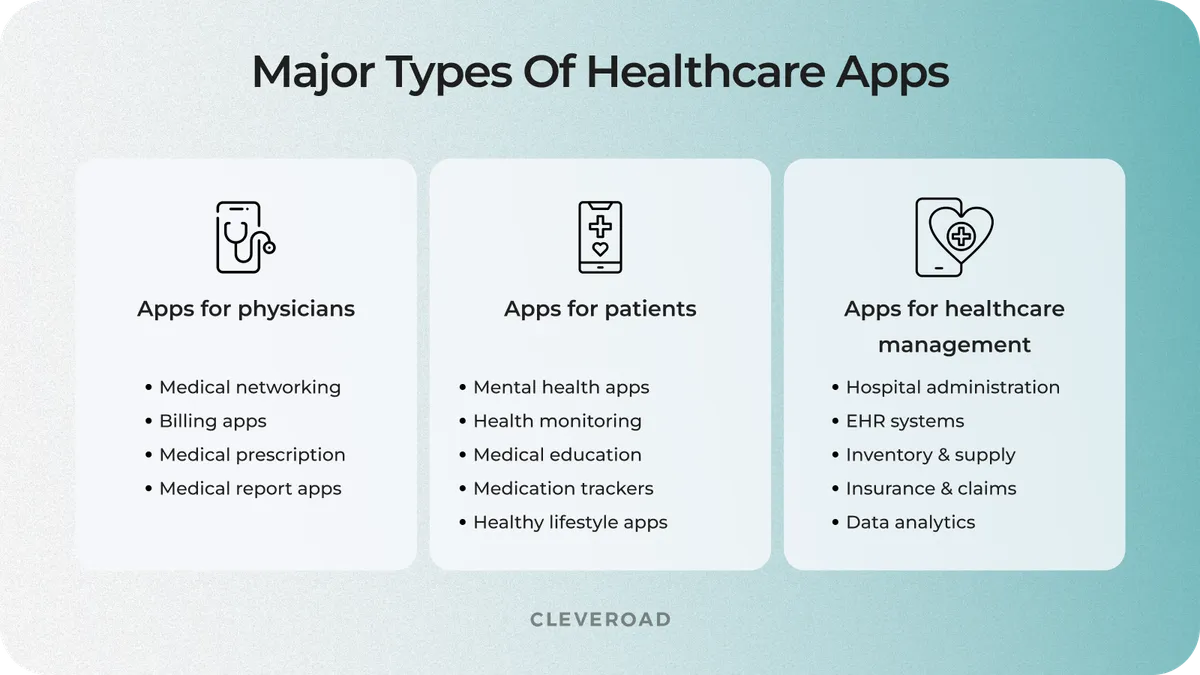
Types of healthcare applications
Apps for professionals and medical facilities
These solutions are built to support physicians, nurses, and other medical staff in their daily routines, helping them deliver better healthcare outcomes. Designed for professional use, the medical platforms are more complex and filled with advanced features that empower specialists to use the app efficiently across various medical scenarios.
Medical networking
Even though physicians are pretty busy and are rare guests on popular social media, they also need a way to communicate with their colleagues, share expertise, and improve the decision-making process. The well-known medical networking apps are:
- Daily Rounds
- Doximity
- Sermo
Telehealth
Telemedicine development costs are aimed to let physicians schedule appointments with patients and provide consultation using in-app messaging or video calls. Telehealth apps are convenient for both medical facilities and patients as they reduce “no-shows” by 50%, and patients can receive medical consultations in the comfort of their homes. Famous telehealth apps are:
- GoodRx Care
- Doctor on Demand
- Teladoc
At Cleveroad, we develop robust telemedicine systems tailored to clinical workflows. For example, for a US-based client, we built a HIPAA-compliant Telemedicine Platform for US Clinics that enables remote consultations, in-app scheduling, and smooth EHR integration. The platform improves accessibility, streamlines communication, and ensures care continuity, while following industry best practices for data security and usability.
Medical prescription apps
E-prescription app development lets physicians pick the right drugs for each patient, pack it into a convenient list, set and control dosage, avoid Adverse Drug Events (ADEs), or cancel prescriptions at any time. Some of the apps like RxEasy and STAT allow prescriptions to be printed so patients can easily show them in any pharmacy.
Medical records apps
Simply put, healthcare mobile apps development for medical records is intended to simplify collecting and updating the patients’ health records. This includes vital indicators (blood pressure, temperature, etc.), medical examinations, prescriptions, appointments, and other information essential for physicians to track the overall treatment process. There are several apps that are quite popular among physicians:
- DrChrono Practice Management
- RXNT
- Meditab
Billing apps
Billing healthcare app development streamlines the overall billing process and digitalizes operations like claims management, accounting, payment processing, and patient registration in medical facilities. There are several popular billing apps as an example for mobile healthcare app development:
- Advanced MD
- EpicCare EMR
- Waystar
How to make a medical billing software to satisfy your medical practice needs? Learn about how it may help you streamline financial processes, features to implement, and more in our guide
Apps for patients
The name speaks for itself. These apps are designed to make the patients’ lives easier. Simple yet useful along with basic medical assistance, these apps cover a wide range of wellness aspects.
Mental health apps
Mental health app development aimed to make therapy more accessible, efficient, and flexible. They can assist with fighting depression, stress, anxiety, and sleep disorders with the help of pre-recorded meditations, breathing exercises, gamification elements, and more.
Popular examples of mental health apps contain:
- Headspace
- Calm
- BetterHelp
Cleveroad partnered with a US-based mental health organization to build Nedley Scorecard: a cross-platform app that helps users manage insomnia, anxiety, and depression through structured self-assessments, progress tracking, and personalized recommendations. We developed a secure, HIPAA-compliant MVP with dynamic dashboards, user profiles, and data visualization tools. As a result, our client received a scalable, user-centered platform that supports mental wellness and enables data sharing with practitioners.


Medical education
The main idea of education health app development is to create a reliable database with up-to-date medical information for students, doctors, and regular users who want to know more about healthcare. There are great examples of this type:
- Medscape
- Clinical Sense
- Lecturio Medical Education
Medication trackers
Medication tracking apps are quite popular in healthcare app development thanks to their overall simplicity as they help users take their pills on time. Besides simple scheduling and reminders, these apps can track specific drugs in pharmacies nearby, letting users know where the cheapest offer is. Among all medication trackers, there are several established solutions:
- ScriptSave WellRx
- Mango Health
- Medisafe Pill Reminder
Healthy lifestyle apps
This category brings together many different applications, such as fitness apps, brain training apps, self-improvement apps, and many others that make a healthy lifestyle much easier to achieve. Notable examples of such applications are:
- Elevate: Brain Training
- Remente
- Results Wellness Lifestyle
Health monitoring
Monitoring medical app development comes with symptom checkers to give recommendations on medication intake or treatment advice. They can also help manage current chronic conditions like cancer, diabetes, and so on. The well-known examples of monitoring medical app development are:
- WebMD
- Ada
- The Diary
What is vital to know about remote patient monitoring in 2026? Go through our guide and learn about how RPM works and why it may come in handy within your medical business
Healthy lifestyle apps
This category brings together many different applications, such as fitness apps, brain training apps, self-improvement apps, and many others that make a healthy lifestyle much easier to achieve. Notable examples of such applications are:
- Elevate: Brain Training
- Remente
- Results Wellness Lifestyle
Apps for healthcare management
These solutions focus on improving operations and data management across hospitals, clinics, and other medical organizations. Through health application development, providers in the healthcare sector can automate manual tasks, enhance coordination, and make better clinical decisions. Such an app can range from hospital administration tools to data analytics dashboards, all designed to integrate seamlessly with existing healthcare systems.
Hospital administration platforms
These systems help manage patient admissions, staff scheduling, and workflow optimization. They reduce administrative load and ensure smoother operations within medical facilities. Some popular examples of hospital administration apps include:
- eHospital Systems
- SoftClinic
- CureMD Hospital Management
Cleveroad developers also create scalable hospital management solutions that simplify internal workflows and reduce administrative overhead. For example, we built a Clinic Management System for a healthcare provider looking to unify operations across departments: from admissions and billing to staff scheduling and performance analytics. The platform streamlines hospital processes, improves data transparency, and reflects modern mobile health app trends by offering secure access to critical information in real time.
Electronic Health Record (EHR)
EHR applications store, process, and share patient data securely in real time. They serve as the backbone of various healthcare institutions by ensuring interoperability, compliance, and accuracy. The well-known EHR solutions are:
- EpicCare EMR
- Cerner Millennium
- Allscripts Sunrise
Inventory & supply management
These apps control medical stock levels, prevent shortages, and reduce waste by tracking usage and expiration dates. To choose the right healthcare system, look for integration capabilities with pharmacy and procurement modules. Key examples for inventory and supply management applications are:
- Health Inventory Pro
- TME Inventory Management
- Infor CloudSuite Healthcare
Insurance & claims management
Such solutions automate billing, claims processing, and policy verification, helping clinics reduce delays and ensure accurate payments. When planning your healthcare app idea, consider the importance of HIPAA compliance and secure data flow. Insurance and claims management app examples include:
- Waystar
- Kareo Billing
- NextGen Financial Suite
Data analytics dashboards
These tools visualize patient outcomes, financial performance, and resource allocation. In right healthcare app development, analytics modules help executives make evidence-based decisions and optimize operations. For example, the key data analytics dashboards include:
- Tableau Healthcare Analytics
- Power BI for Healthcare
- Sisense for Healthcare
Benefits of Healthcare Application Development
Healthcare mobile app development is a versatile instrument that delivers multiple advantages for providers and users by improving efficiency, accessibility, and overall healthcare experiences. Let's take a look at the benefits of such apps:
Benefits for healthcare providers
Health apps development streamlines core processes and reduces manual workload, improving decision-making and bottom-line performance.
- Improved workflows and patient management. Centralized data and automation simplify handling appointments, records, and care plans.
- Reduced admin costs. Automating billing, scheduling, and reporting cuts overhead and improves resource allocation.
- Real-time access to health data. Doctors and nurses can make faster, better-informed decisions.
- Remote monitoring. Continuous care becomes possible through connected devices and alerts.
- Better team communication. In-app chat and dashboards enhance flows between clinicians.
Benefits for patients and general users
Healthcare apps enhance the overall experience, giving users more control and confidence.
- Easy access to care. The apps assist in booking appointments, viewing records, and consulting doctors from one mobile app.
- Personalized treatment plans. Automation enables tailored care based on user data, medical history, and so on.
- Medication reminders. Built-in alerts help users stick to prescriptions and avoid errors.
- Wellness tracking. Apps track fitness, sleep, and diet to promote healthy habits.
- Stronger engagement and retention. Convenient, consistent digital care encourages patients to stay connected to their provider.
We provide a wide range of healthcare software development services. Check out our service page to learn more about opportunities cooperation with us may bring to your healthcare app success
MVP Features Checklist for Healthcare App Development for Your Establishment
In health mobile app development, it's essential to clearly understand the product you want to build before you start the development process. Creating a Minimum Viable Product (MVP) is a crucial step in this process. MVP allows you to test your idea, validate assumptions, and get user feedback while minimizing development costs and time.
Let’s explore the key aspects of creating an MVP for mobile app development for healthcare:
Secure authorization and authentication
This is an essential and primary feature in healthcare app development. It is the process of verifying the identity of users accessing the application and ensuring that only authorized users can access the sensitive information within the app. For instance, a two-factor authentication process may be implemented, requiring a password and a unique code sent to the user's phone or email, or biometric authentication, such as fingerprint or facial recognition, may be used.
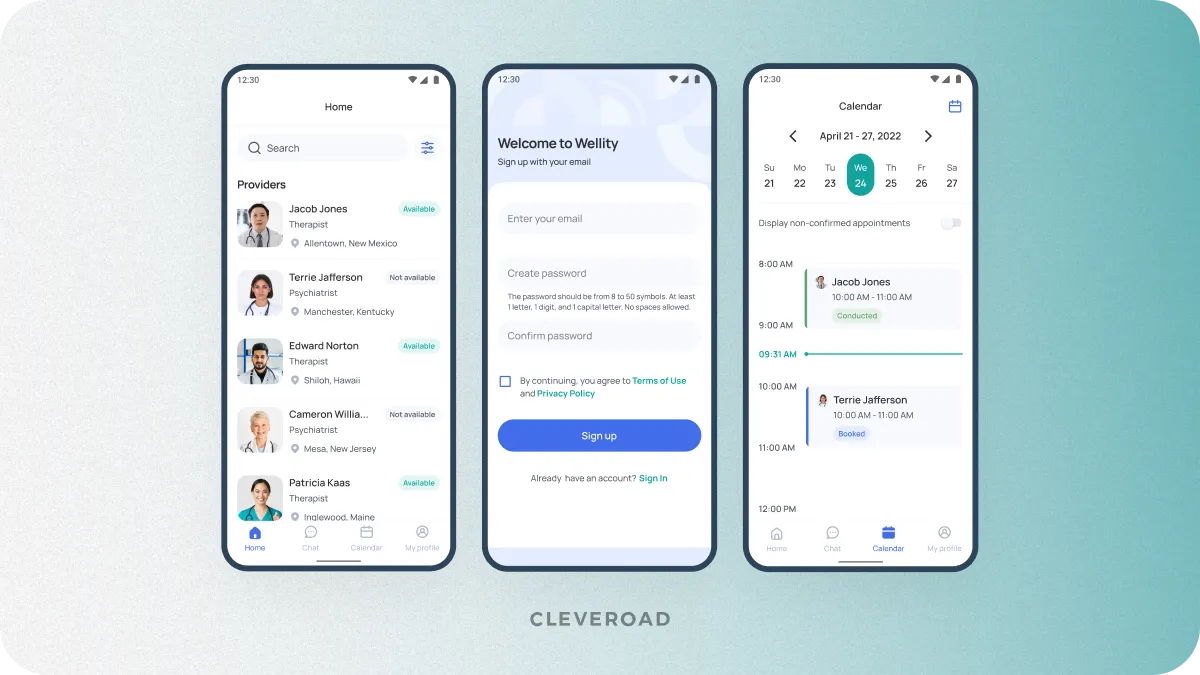
Authorization feature designed by Cleveroad
Data privacy and compliance
For any medical mobile application development, strict adherence to healthcare regulations is non-negotiable. To ensure your app meets HIPAA, HL7, or FHIR standards, it’s crucial to integrate secure data encryption protocols, permission-based access, and compliance-ready infrastructure from the early stages of the development of healthcare apps. Our team at Cleveroad helps clients implement scalable compliance features that cover both US and EU regulatory frameworks.
Profile screen
The profile functionality is an essential part of the telehealth app. The user should be able to fill in personal information, add a photo, write a medical history, and generally manage and edit personal information according to up-to-date data. This significantly adds to personalization for both patients and practitioners.
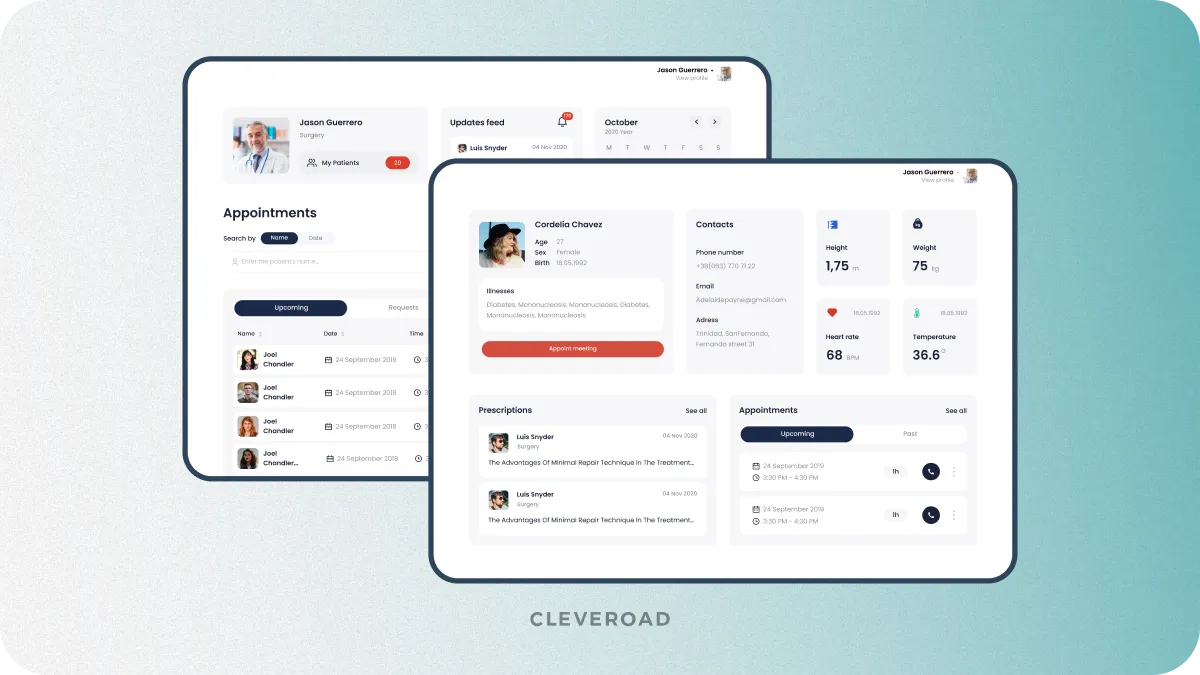
User profile screen feature example designed by Cleveroad
Search and filter options
Finding a physician should be simple yet effective. It’s a good idea to add filters within medical mobile app development that’d let users find a doctor based on set criteria such as specialization, experience, or appointment cost.
Appointment scheduling
This feature works well in both ways. The physician receives a calendar to schedule appointments and control their number during the week. In the meantime, patients have access to the doctor's schedule for a quick booking that is convenient for both parties.
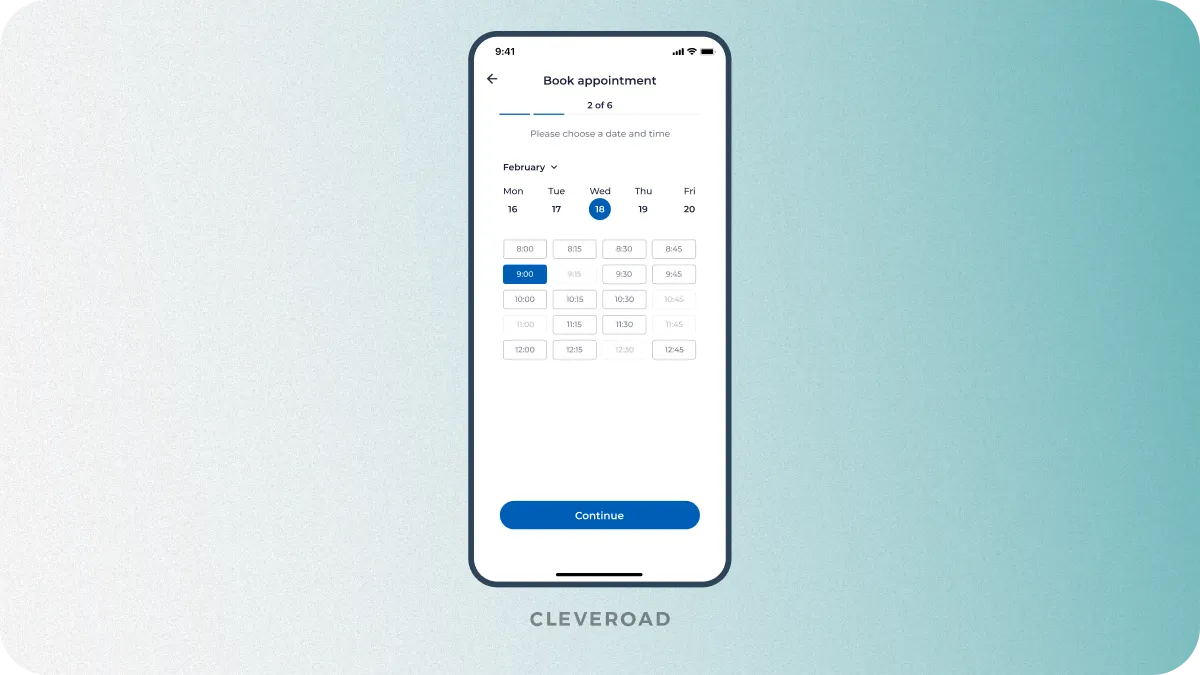
Appointment booking feature example designed by Cleveroad team
Dashboards and analytics
Admins and physicians often rely on data dashboards to make informed decisions. Integrating analytics modules in your MVP lets users visualize patient trends, filter metrics, and track appointments or clinical outcomes in real time. As a medical mobile app development feature, it strengthens clinical workflows and business insight. Cleveroad, as a best healthcare app development company, uses industry-proven frameworks to help you bring your healthcare app to life with powerful, secure dashboards that scale with your product.
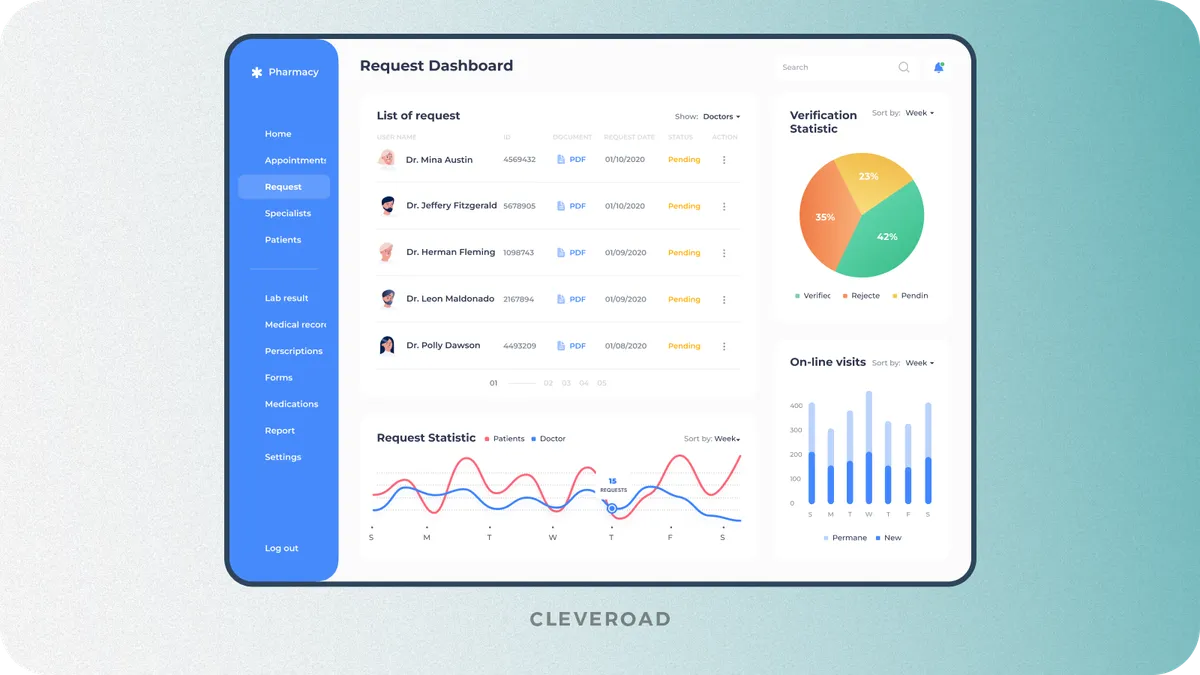
Admin dashboard for telehealth platform created by Cleveroad (Source: Dribbble)
Video and voice calls
This feature is the foundation of all telehealth apps. Video calls are often made using WebRTC, HLS, or MediaStream protocols. These technologies support real-time communication via the camera and microphone of mobile devices. During video and audio calls, both parties should have a stable connection and no trouble with the audio or video.
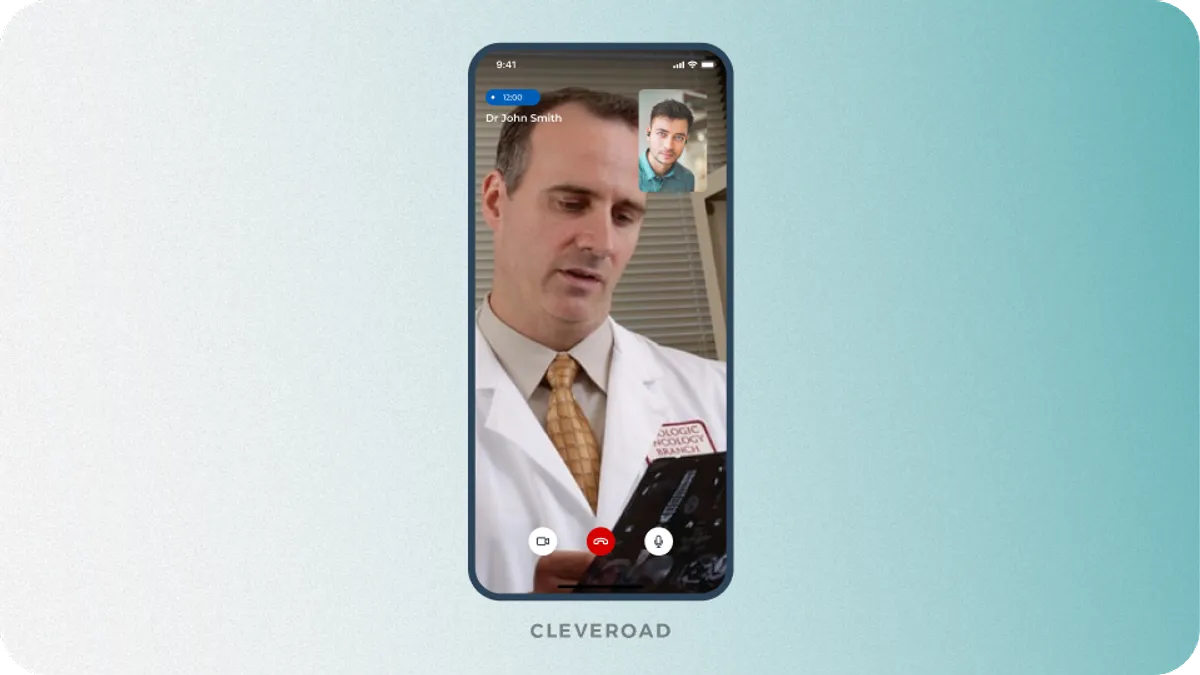
In-app video call feature example designed by Cleveroad
Payment options
This feature is useful for everyone. Users can pay for the doctor's services, the platform holder gets a commission, and the doctors get paid for their work. The main way to add online payments is to implement a payment gateway. This could be PayPal, Stripe, or Braintree. Besides that, it’s worth implementing payment directly from a patient's credit card.
Online chat
If the doctor can’t see the patient at the moment, the user should be able to ask a question or leave a message for a physician using an in-app chat. The chat is useful enough for both parties. The patient can send various documents and media files that are important for the consultation with medical mobile app development, while the doctor can clear up the course of treatment or send a file with the prescription.
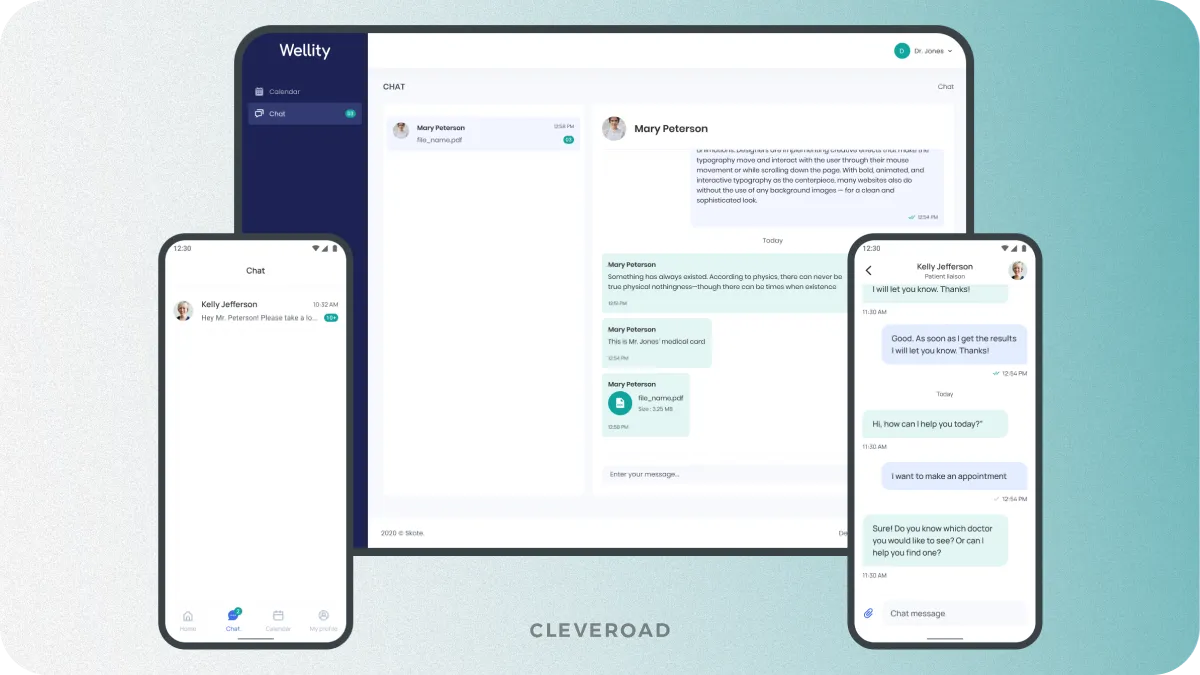
Chat module in healthcare apps feature example designed by Cleveroad team
Reminders and notifications
Through reminders and notifications, medical apps not only keep users on track with timely alerts but also consider their location, enhancing the overall medication management experience. This feature ensures that patients never miss a dose and stay well-informed about their health.
These core features make your app functional and user-friendly from day one. At Cleveroad, we offer MVP development services to help you validate your idea with minimal risk and cost
How to Build a Healthcare App Step-by-Step
Professional healthcare app development is impossible without a clear understanding of your goals, app features, and a clear plan. Therefore, you should apply to a competent software development vendor. Reliable and experienced partners will assist you in selecting the kind of custom healthcare apps development you want, researching target audience details, what problems your healthcare product will solve, and how.
Whether you're building a hospital-facing platform or a patient management app, an experienced software development partner will guide you through every stage: from ideation to deployment. With a custom approach, they’ll ensure your healthcare app aligns with your business goals, addresses user pain points, and meets industry standards. By leveraging professional health app development services, you can launch a solution that’s functional, scalable, secure, and ready for real-world use.
Let’s go over 7 steps of healthcare mobile application development to unblur this process for you.
Step 1. Problems' identification
What problem do you want to solve with your app? Maybe you want to create a fitness app to help users keep fit. Or you want to save users money when buying medications. The opportunities for medical app development are vast, so your initial requirements and the tech team's research will help pick the relevant type of medical app. Your final decision will impact the following factors that will be considered and studied by your software development partners:
- Number of competitors
- Barriers to entry
- Feature list
- Target audience
For example, if you are looking on how to create a fitness app, you’re likely to have a hard time. This type of app has probably the largest market share. In addition, you’ll have to compete with well-known apps like Fitness Buddy, Map My Run, JEFIT Workout Planner, and others. Business Analysts will carefully study the most popular rivals and come up with a truly unique solution that’ll make you stand out.
Step 2. Find a credible software development provider
The next step is to find a technical vendor who can help build the application. When selecting a vendor, you should consider the following things:
- Experience in the medical industry and healthcare software development services
- Availability of a portfolio that demonstrates experience in developing apps similar to yours
- The healthcare app development process the vendor will use, including testing and debugging
- The cost to make healthcare app and the expected time it will take to develop the app
- Availability of specialists who know the requirements and legislation in the medical industry
After selecting several vendors, you should create an RFP for software development. RFP stands for Request for Proposal, a document companies use to solicit vendor proposals to complete a project or provide a service. An RFP typically outlines the project scope, objectives, requirements, evaluation criteria, and any other pertinent information vendors need to submit a proposal. The goal of an RFP is to ensure that vendors clearly understand the project requirements and can provide a proposal that meets the company's needs. RFPs are commonly used in healthcare apps development to help companies find the right vendor to help bring their vision to life.
If you are experiencing difficulties with the RFP, you can always order a consultation with a specialized IT provider to get the request for a proposal template and professional recommendations.
Learn about how to hire dedicated development team for your healthcare app project regarding costs, valuable tips, and more
Step 3. Solution design stage
Upon agreeing on the partnership, the selected vendor will contact you to clarify initial inquiries that are addressed to determine the primary objectives and business context. Then, you and your IT partner schedule a meeting with the Solution Team to discuss the project in more depth, analyze it, and specify requirements. The Solution Design team, composed of business analysts, solution architects, and designers, if needed, reviews the application and preliminary information.
At Cleveroad, we offer a free Solution Design workshop to help you find the right technical approach to your healthcare challenge and define a clear path forward.
Step 4. Discovery phase
The Product Discovery Phase is a crucial step in any software development project that helps transform your project requirements into a comprehensive plan. It serves as a blueprint for the development process and ensures that the end product meets your needs and specifications. The goal of the Discovery Phase is to gather all necessary information and requirements that will help streamline the healthcare development process and improve the final product's quality.
During this step, the healthcare mobile app development team collects information about the project, such as the platforms that need to be covered (Android, iOS, web), features to include, and third-party services to integrate. The specialists use this information to create a detailed plan that outlines the project's scope, objectives, timelines, and milestones. By establishing a clear plan at the outset, the development team can identify potential roadblocks and make adjustments to ensure the project stays on track and is completed on time and within budget.
Step 5. Build healthcare app MVP
As we’ve already covered, a Minimal Viable Product, or simply MVP, is an app that only has essential features that allow users to solve their problems. MVP building is the best choice when:
- You need to validate the idea
- You’re low on resources
- You need a fast time to market
Thus, before creating an MVP, you and your IT vendor should define the minimum feature set that delivers clear value to your target users. Focus on solving one or two core problems: it helps prioritize development efforts, reduce scope creep, and keep costs under control.
Once features are finalized, the team moves into design, development, and initial testing. At this stage, engineers build the backend and frontend components, connect APIs, and ensure the app meets baseline compliance and security requirements. The MVP should go through functional testing, usability checks, and smoke testing before release to ensure it works reliably and is ready for user feedback.
Step 6. Compliance testing and certification
At this stage, your app goes through strict verification to ensure it meets all industry-specific data privacy and regulatory requirements. In the development of healthcare solutions, this step is not optional. It’s essential for launching in real-world clinical environments.
Testing covers multiple layers of compliance:
- HIPAA (for US-based apps) to safeguard protected health information (PHI)
- GDPR (for EU users) for handling personal data with consent and transparency
- HL7/FHIR integration to ensure your app communicates securely with EHR systems and other medical software platforms
- Additional regional or platform-specific certifications where needed (e.g., ISO/IEC 27001, SOC 2, Apple/Google store policies)
A qualified development partner will perform thorough security audits, code-level vulnerability scans, encryption validation, and integration checks. At Cleveroad, we offer a full-cycle compliance support service that ensures your app meets the legal, technical, and ethical standards from the very beginning. This step protects you from regulatory setbacks and helps launch with confidence — a key success factor in medical mobile app development.
Step 7. Collect feedback, update, repeat
So, you’ve released your MVP. Now, it's time to collect and analyze user feedback. Don’t neglect the audience’s opinion; it can fuel your ideas for future updates. After the release, you can support the app by expanding its functionality and implementing various quality-of-life improvements. This process involves expanding on the initial MVP and adding features that users have requested or that you have identified as necessary.
The primary step is to analyze the feedback and prioritize features based on their impact and feasibility. Then, the development team can build and integrate the additional features into the app. This process may require changes to the app's architecture and additional testing and quality assurance measures.
As the app takes shape, it's important to continuously gather feedback from users and stakeholders to ensure the solution meets their needs. This can help identify areas for improvement and guide future healthcare application development efforts.
Key Trends in Healthcare Mobile App Development
The health application development market offers new solutions to meet dynamic user requirements. Distance sessions need to be conducted simply and conveniently via mobile devices with digital therapy tools, and modern architectural trends such as AI, ML, and chatbot implementation are becoming essential. AI and ML can enhance decision-making processes and provide valuable insights, making accurate diagnoses and treatment methods possible.
To keep your app user-friendly and up-to-date, it's essential to incorporate these solutions and technologies. Below, you may find the range of trends in healthcare app development that you can benefit from:
Artificial intelligence (AI) and machine learning (ML)
By leveraging these technologies, healthcare apps can be developed with advanced features such as predictive analytics, natural language processing, and image recognition. ML in healthcare can help providers automate tasks such as diagnosis, treatment recommendations, patient monitoring, and early risk detection.
This technology is often implemented in medical image analysis software development to provide faster operation and efficient diagnostics. AI technology is applied in the production of new medicines and vaccines. The ways to utilize AI technology, and lots of healthcare establishments have already implemented this solution, especially for the decision-making process, which is highly beneficial for therapists to detect the diagnosis and pick a proper treatment.
Discover our AI Automation in Healthcare guide to know how you can benefit from technology!
Blockchain
Blockchain represents an essential trend in medical mobile app development, bringing unique opportunities to improve security and efficiency. In the context of healthcare applications, Blockchain enables secure storage and transmission of medical data, ensuring its integrity and protection from unauthorized access. The technology also supports the creation of smart contracts, facilitating the automation of agreements and providing transparency in data processing. Blockchain security is the foundation of healthcare development that promises to improve privacy issues, information sharing between parties, and the overall efficiency of medical processes.
Cybersecurity & data anonymization
While healthcare data security is no longer a trend but a baseline requirement, what is trending today are more sophisticated approaches to cyber resilience and data minimization. The rise of AI-driven features and IoT integrations means that the attack surface in mobile health apps continues to expand, as well as the need for multi-layered protection.
Modern mobile app development for healthcare involves embedding security directly into the architecture via:
- Zero Trust frameworks – eliminate implicit trust and secure every access point within the system
- End-to-end encryption (beyond REST API level) – protect sensitive data throughout the entire transmission path
- Federated learning models – enable AI training on-device without storing patient data centrally
- Automated anomaly detection and real-time threat response – identify unusual activity early and prevent breaches before damage occurs
- Advanced data anonymization techniques – ensure compliance with HIPAA, GDPR, and evolving global privacy regulations while enabling data use in analytics
Security is no longer about encrypting fields, but it’s about designing healthcare apps that are private by design, proactive against threats, and adaptive to evolving risks. Cleveroad helps implement these technologies as part of compliance-first architectures, ensuring your healthcare solution is protected across every touchpoint.
Learn more about healthcare data security, ways to secure your medical data, vital data security standards, and more in our guide
IoT and wearables
The integration of IoT in healthcare and medical wearables is reshaping mobile healthcare by enabling continuous, passive health monitoring and real-time data sharing. From smartwatches tracking heart rate to FDA-cleared glucose monitors, wearables feed healthcare apps with live metrics that help detect early symptoms, trigger alerts, and personalize care pathways.
Successful medical mobile application development today must consider interoperability with devices like Apple HealthKit, Google Fit, or Bluetooth-enabled sensors. It’s also essential to ensure encrypted data transmission and remote device management, especially for hospital systems and insurers using large-scale RPM platforms.
Cloud computing
Cloud-based infrastructure is one of the strongest enablers in medical application development. It ensures scalability, high availability, and real-time data synchronization across devices, platforms, and providers. Whether you're building a patient-facing app or an admin dashboard, cloud computing in healthcare allows you to store, process, and retrieve sensitive health data securely and flexibly.
Key advantages of cloud computing in health app development include:
- HIPAA-compliant cloud environments (AWS, Azure, GCP)
- On-demand infrastructure scaling for peak traffic
- Integrated CI/CD pipelines for faster release cycles
- Real-time backups and disaster recovery options
By combining cloud architecture with robust DevOps services, Cleveroad ensures your app can scale and evolve without risking stability or compliance.
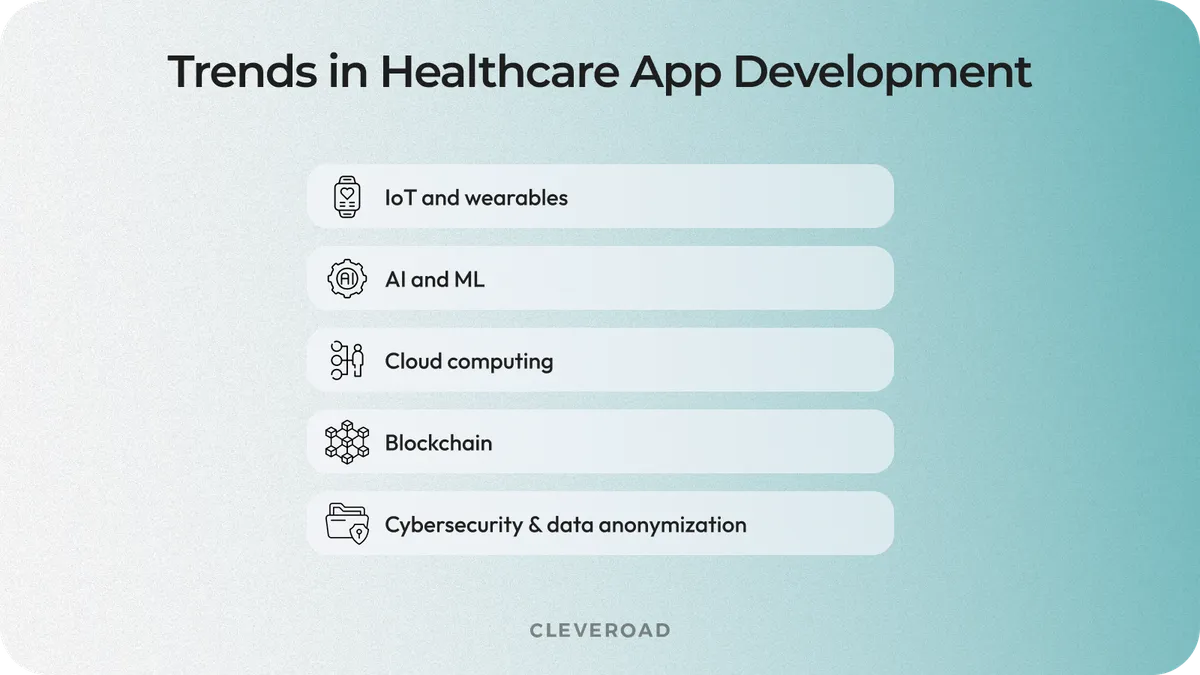
Key trends of healthcare application development
Best Practices for Medical App Development
The vital question of health application development is the specifics of this industry. To comply with all the nuances of the solution architecture, it is worth considering the following points:
Security and compliance in healthcare app development
Security and compliance are critical in healthcare apps that handle sensitive patient data, clinical workflows, and payments. From day one, your app must combine technical safeguards with regulatory alignment across regions and domains.
Core protection methods:
- End-to-end encryption (E2EE)
- Multi-factor authentication (MFA)
- Session expiration and access control
Key regulations to consider:
- Data protection & privacy: HIPAA (US), GDPR (EU), PIPEDA / PHIPA (Canada), ISO/IEC 27001
- Interoperability & clinical standards: HL7 v2, HL7 FHIR, DICOM, ICD-10, IHE Profiles
- Telemedicine & care delivery: CQC (UK), EPS (UK), eRx (US/EU), state parity laws (US)
- e-Signatures & consent: eIDAS (EU), ESIGN Act & UETA (US), UNCITRAL Model Law
Laws vary by region and data type, so ensure your architecture is designed for secure storage, compliant access, and audit readiness.
How do you comply with HIPAA requirements? Read our extensive guide and learn about essentials steps and practices to implement within your healthcare app development
Interoperability
Interoperability is one of the greatest complexities of the entire medical domain. It implies smooth data transmission among diverse platforms, gadgets, and software solutions. The process of health app development may require integration with the particular medical establishment's systems, tools, or devices the institution currently possesses. To enable safe, seamless, and efficient communication among them, you should ask your software vendor to remember about HL7 integration.
User-centric UI/UX design
UI/UX design services are vital for healthcare mobile application development. The target audience of healthcare apps is quite extensive. Aiming for maximum reach, your design should be as user-friendly as possible. To nail it, your tech experts should follow several important UI/UX design rules:
- Optimize the user journey inside your app. Create a user persona, and based on their desires and expectations, inspect each touchpoint in your app to find weak spots in the design.
- Minimize the number of actions a user should take to complete a task. Your team may group related content to make it accessible in one click. For example, Use the Progressive Reduction method. Start from your standard design layout and gradually reduce unnecessary elements to lower the number of actions that lead to a completed task.
- Show important information at the beginning of the user journey. If you’re making a fitness app, the burned calories and steps taken should be placed right away on the first screen. If it’s a pill reminder app, show the nearest scheduled pills and the time left before taking them.
- Make design responsive. It’s worth taking care of how the app will look on screens of different sizes. Make sure that your app looks similarly great on any screen size.
Integration with third-party applications
Seamless integration with third-party applications is crucial for healthcare app development. This ensures that patient data is easily exchanged between different platforms, providing a more comprehensive view of their health. Without integration, the scope and utility of healthcare solutions are limited, hindering the ability to offer better care and improve the patient experience. As such, integration is a top priority for medical application development companies.
The Cost of Healthcare Application Development
Finally, it’s time to discuss another important consideration of medical app development—how much does it cost to build a healthcare solution? In general, the cost to develop a medical app ranges from $100,000 to $300,000+. The price varies depending on the software types, features complexity, design, integrations, and vendor’s hourly rates.
Ensuring compliance with healthcare regulations is also a crucial factor, as it impacts the development process and overall cost. A successful healthcare app must cater to the needs of patients and healthcare providers, offering seamless interactions and value. Whether you're looking to create an app to optimize the healthcare system or enhance the experience for app users, every healthcare project demands careful planning to ensure it meets industry standards.
Here’s a breakdown to help you estimate total cost more accurately:
- MVP development: From $80,000 to $150,000+ for basic features like login, scheduling, video calls, chat, and EHR integration. Example: A telemedicine MVP starts from $40,000–$70,000+.
- Cloud & infrastructure: Around $500–$2,000/month for hosting, storage, and server costs.
- Post-launch operations: $4,000–$10,000+/month for app maintenance, updates, and security monitoring.
To give you a tailored estimate, our team of Healthcare domain experts first defines the scope of your solution and calculates the cost for your specific healthcare app idea.
| Feature | Approx development time (h) | Approx cost ($) |
Registration and login (Patient + physician) | 76 hours | $2,660 |
Profile screen (Patient + physician) | 81 hours | $2,835.00 |
Search, filter options and ratings | 103 hours | $3,605.00 |
Appointment scheduling (Patient + physician) | 185 hours | $6,475.00 |
Video and voice calls (Patient + physician) | 136 hours | $4,760.00 |
Online chat (Patient + physician) | 121 hours | $4,235.00 |
Payment options | 36 hours | $1,260.00 |
Admin panel | 271 hours | $9,485 |
Backend part | 1120 hours | $39,200 |
Frameworks and libraries implementation | 56 hours | $1,960 |
Code documentation | 17 hours | $595 |
Total | 2202 hours | $77,070 |
There are many specialists involved in the development process. Their services are also included in the final price. Using our telehealth app as an example, we want to show who participates in the development and the project's final cost.
By breaking down the roles involved, clients gain transparency into how their budget is allocated and which contributions drive the most value at each stage. Moreover, the roles breakdown also helps prioritize features more effectively and align development efforts with real business goals.
| Development team member | Task | Approximate time (h) | Approx cost ($) |
Mobile developers (iOS and Android) | MVP features development | 1280 hours | $128,000 |
Frontend developers | Admin panel development | 160 hours | $8,000 |
Backend developers | Backend part development | 1120 hours | $56,000 |
UI/UX designers | Wireframes and mockups creation | 160 hours | $8,000 |
Project Manager services | Development process overseeing, development reports | 400 hours | $20,000 |
QA engineer services | App testing, bug reports creation | 600 hours | $30,000 |
DevOps | Development process automation, DevOps methodologies | 120 hours | $6,000 |
Business analyst | Discovery phase, creation of final estimate and specification | 160 hours | $8,000 |
Team lead | Project architecture development, code review | 180 hours | $9,000 |
Total | 4180 hours | $273,000 | |
This estimate is approximate and includes MVP development expenses only. For a more precise calculation of your project, contact us and get an estimate from our professionals, as healthcare domain applications have a number of key peculiarities that can significantly affect the cost of their architecture. Therefore, each project case is worth considering individually with an expert to get accurate calculations.
Cleveroad Experience in Healthcare Application Development
Cleveroad is a healthcare app development company from the CEE region. Since 2011, we've been helping healthcare organizations, clinics, medical device manufacturers, and other health-related businesses improve caregiving, enhance client satisfaction, boost clinic management, and optimize overall workflow within custom healthcare software development services.
We provide a wide range of healthcare software services, including custom software development from scratch, software modernization, and facilitating third-party integrations (e.g., EHR, EMR, e-RX services, patient portals), and more.
Besides, we thoroughly keep up with global security methods to ensure trustworthy cooperation and deliver highly secure medical software solutions to our clients. This includes HIPAA, GDPR, and PIPEDA, and we are also certified with ISO 27001:2013, proving our services align with leading world data security and integrity standards.
To demonstrate our expertise, here are examples of the health solutions we've built for our clients:
- Quality Management System. A B2B SaaS solution for streamlining the doc flow and essential processes required for obtaining FDA and ISO certification in the production of medical devices.
- IoT System for Monitoring EKG and Blood Oxygen Level. A mobile telecare solution designed to track heart rate and blood oxygen levels through a user's smartphone, involving a mobile application that wirelessly connects with IoT devices.
- E-Learning System for Official Certification. An online educational platform tailored for medical students, featuring a comprehensive learning material database and continuous training services through subscription models.
- IoT System for Hydration Monitoring. A software solution for an IoT hydration tracker that monitors and controls hydration levels for medical and wellness purposes. It tracks data from IoT sensors and enables the creation of training and care programs through the Admin panel.
- RPM Solution for Behavioral Health Support. A free mood-tracking app helps users combat depression by enabling them to log daily progress, receive well-being notifications, and follow personalized schedules for improved mental health.
Here is what Breanne Butler, project manager at Prime Path Medtech, says about our mutual work on Quality Management Systems for medical device manufacturers:
Breanne Butler, project manager at Prime Path Medtech, provides feedback about collaboration with Cleveroad on Quality Management System.
Let’s start building your medical app together with Cleveroad
With over 15+ years of expertise in the healthcare domain, we're ready to create a secure and modern healthcare app providing consistent IT assistance during each stage of your app development
Healthcare app development involves seven critical steps:
- Step 1. Identify your healthcare business challenges and needs
- Step 2. Seek out a reputable software development partner
- Step 3. Solution design stage
- Step 4. Prepare requirements, feature set and design prototype
- Step 5. Develop a healthcare app MVP (Minimum Viable Product)
- Step 6. Compliance testing and certification
- Step 7. Gather user feedback, implement updates, and iterate as needed
The cost to develop a healthcare app typically ranges from $100,000 to $300,000+, depending on its type, feature complexity, compliance requirements, and vendor rates. For example, a basic telemedicine MVP may start from $40,000 to $70,000+, with additional post-launch costs (cloud, security, maintenance) averaging $5,000–$10,000+/month.
The development time for a mHealth app can vary based on factors such as complexity, features, and customization. On average, an app must take between 1200 to 2500+ hours to develop, but this is a general estimate. Patients and healthcare providers benefit significantly from these apps, making their creation a priority for many organizations. Partnering with a mobile app development company can streamline the process as they possess the expertise to develop healthcare solutions effectively.
Healthcare app development improves care accessibility, streamlines clinical workflows, and enhances patient engagement through real-time data, remote monitoring, and personalized services. It also helps providers reduce administrative costs and deliver faster, more accurate medical decisions.
There are several common monetization models for mHealth solutions:
- In-app ads. The app is completely free, but it shows ads to users.
- Freemium. The app is still free, but some features can be unlocked through in-app purchases.
- Subscription. Users must pay for a subscription (weekly, monthly, yearly).
- Pay-per-download. Users buy an app with a one-time payment.

Evgeniy Altynpara is a CTO and member of the Forbes Councils’ community of tech professionals. He is an expert in software development and technological entrepreneurship and has 10+years of experience in digital transformation consulting in Healthcare, FinTech, Supply Chain and Logistics
Give us your impressions about this article
Give us your impressions about this article
Comments
7 commentsThanks for sharing this informative article. A must-read for anyone interested in healthcare app development.

We're glad that you found it useful
I have an idea to build an healthcare app but I don't know what steps I should follow. Your blog is really awesome with full of information.
Hi there, Thanks for sharing such an awesome blog with us. It's really helpful for me to build an healthcare app.
Hi there, I really appreciate your work! I am a researcher I do research everyday, but never find such articles, I visited your all pages, and it's really very impressive, Keep sharing such articles to help us. Good Luck
Such a wonderful Article In the last few years, the sciences and health care industries have been undergoing significant disruptions. This year's COVID-19 revealed how vulnerable the health care industry is to change and how it needs structural and technological change. If you are looking for a health mobile app development company, then no more Visit consagous.co Keep Posting
You are posting a very good article. Thanks for sharing this useful article with us. keep posting.
yes, 40% of physicians believe telehealth apps could reduce in-office visits. 74% of the hospitals that used mobile apps to collect patient data showed higher levels of efficiency than their counterparts not using any apps. mHealth is the future and we should find solid reasons to before investing in mHealth app.